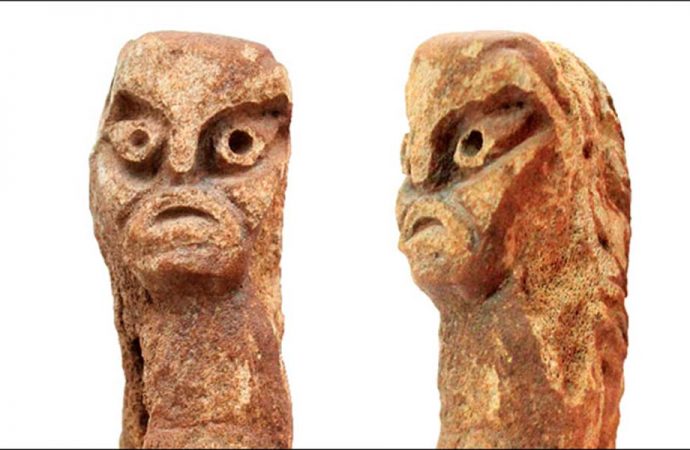Likely from the Okunev culture, might this mysterious ancient figurine with the angry face be a children’s ‘rattle’, to ward off evil spirits?
The ‘very distinctive expression of ferocity and rage’ has never been seen before among ancient Siberian statuettes, say experts.
Fisherman Nikolay Tarasov, 55, made the remarkable Bronze Age ‘catch’ when he dipped his net in the Dudet River near his home in Tisul, Kemerovo region, on a fishing expedition for tench and carp.
Instead of a fish, he netted a strangely shaped stone – a fossilized figurine – the catch of a lifetime. ‘I was about to throw it back in the water – but at the last second I looked at it more closely,’ he said.
‘And I saw a face. I stopped and washed the thing in the river – and realized it wasn’t a stone of an unusual shape, as I thought earlier – but a statuette.’
It has almond shaped eyes, a large mouth with full lips, and a ferocious facial expression.



Fisherman Nikolay Tarasov, 55, made the remarkable Bronze Age ‘catch’ when he dipped his net in the Dudet River near his home in Tisul, Kemerovo region. Pictures: Tisul History museum, The Siberian Times
‘On the reverse side on the head the carver had etched plaited hair with wave like lines. Below the plait there are lines looking like fish scales,’ he said. ‘I went to the local museum – and experts there quite literally jumped for joy, and quite high.’
Speaking exclusively to The Siberian Times, Dr. Pavel German, researcher at the Institute of Human Ecology, Kemerovo, who investigated the 2014 find with colleague Professor Vladimir Bobrov, said: ‘We can say that this figurine is unique, as nothing identical has been found so far.
‘It is interesting that the face depicted on this figurine has a very distinctive expression of ferocity and rage. Usually the ancient – Neolithic and Bronze Age – anthropomorphic sculptures do not have any distinctive expression.
‘This is the other reason, why the figurine is unique. We argue that is was a god or a spirit.’


‘It is interesting that the face depicted on this figurine has a very distinctive expression of ferocity and rage.’ Pictures: Pavel German and Vladimir Bobrov, Tisul History museum
The experts believe the figurine is from the ancient Okunev culture ‘judging by the style’. But recent discoveries at an Okunev site some 300 kilometers’ northwest have led to a new theory about this river find.
Eight horn figurines were found at Lake Itkol in Khakassia which have been described as akin to modern-day children’s rattles but with the purpose of fending off evil spirits. They were discovered in the grave of a baby less than a year old at death.
While far from identical, they are said to be stylistically similar to the fisherman’s pagan god, which is now on display at Tisul History Museum.
‘Our figurine shows a resemblance to those found in child burials at Itkol Lake,’ said Dr. German. ‘When we undertook our research we did not know about the Itkol figurines. Yet while there is a resemblance between them, they are not completely similar.’
For now, it remains a mystery how the ferocious find came to be in the river.


Eight horn figurines were found at Lake Itkol in Khakassia some 300 kilometres northwest have led to a new theory about this river find. Pictures: Andrey Polyakov & Yuri Esin, The Siberian Times
‘The find could have gotten into the water due to different circumstances, among them – the destruction of an ancient child’s burial,’ said Dr. German. ‘The figurine was found in a local river, and we went to the site, hoping there would be more (archeological items), but sadly we had no luck.’
He added: ‘It is hard to tie this figurine to specific Okunev settlements or burials. The closest known settlement from the Okunev culture is located (underwater) in the modern Tambarskoye Reservoir, 10 kilometers from where the figurine was found.’
The find was made upstream of this submerged archeological site. The figurine is made of antler and ‘lines on its head depict the hairs. And on the back there is an ornament which resembles scale. We suppose that it depicts a cape or mantle made of scale.’
It is unclear if it is fish or snake scale, possibly relating to the Lower World in the belief system of this ancient culture.
The Kemerovo object also shows signs that it might have been attached to a tree or perhaps to a baby’s cot.


While far from identical, Itkol figurines are said to be stylistically similar to the fisherman’s pagan god. Pictures: Andrey Polyakov & Yuri Esin
‘There is a hole drilled in the figurine,’ he said. ‘We found a small wooden stick, a twig, inside it.’ So another theory is that ‘the figurine was fixed on a tree branch and at some point it broke, with the small twig left embedded in it’.
Museum guide Ekaterina Vambrikova said: ‘It is true miracle that Nikolay Tarasov found it. We are very proud that the figurine made by legendary Okunevs is in the collection of our museum.
‘It is one of the most significant archaeological exhibit in our collection. It is on display now and we welcome people to come to us and see it. We think that this figurine may depict one of the gods or sprits in which Okunevs believed. It looks a little scary but fascinating, and our visitors love to see it.
‘We heard that the scientists from St Petersburg have found some similar figurines in the grave of the baby (at Lake Itkol) possibly adorning the cradle. So perhaps our figurine was also this kind of such an adornment.’
Source: Ancient Origins

































Leave a Comment
You must be logged in to post a comment.